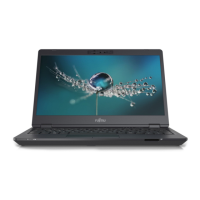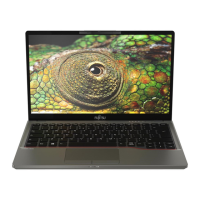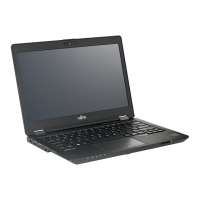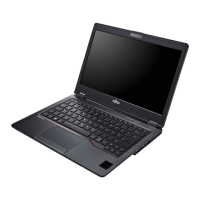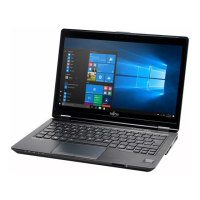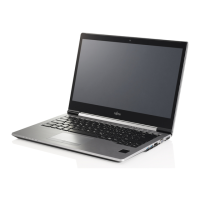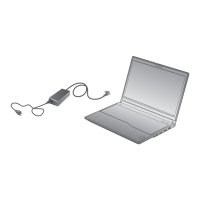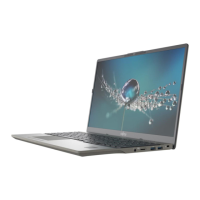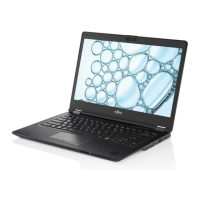Do you have a question about the Fujitsu LIFEBOOK U7313 and is the answer not in the manual?
Provides links to online resources and additional information for the notebook.
Explains symbols and formatting used in the manual for clear understanding.
Details all ports and indicators for the FUJITSU LIFEBOOK U7313 model.
Details all ports and indicators for the FUJITSU LIFEBOOK U7413 model.
Details all ports and indicators for the FUJITSU LIFEBOOK U7613 model.
Provides essential safety information and warnings for handling and operating the notebook.
Specific safety guidelines for using wireless features like Wi-Fi and Bluetooth.
Tips and methods to reduce power consumption and extend battery life.
Guidance on preparing for, travelling with, and transporting the notebook.
Instructions on how to clean the notebook safely and effectively.
Steps for safely unpacking the notebook and checking for any shipping damage.
Guidelines for choosing a suitable and safe environment for setting up the notebook.
Procedure for connecting the notebook to the power adapter and a mains outlet.
Instructions for the initial power-on and software setup of the notebook.
Explanation of the various status lights and their meaning regarding power and keyboard functions.
Step-by-step guide on how to properly turn the notebook on and off.
Overview of the notebook's keyboard layout, key functions, and special characters.
Details the functionality and layout of the virtual numeric keypad on the keyboard.
Explanation of special function keys (Fn keys) and key combinations for enhanced control.
How to configure the F-Lock setting to change the primary function of the upper row of keys.
Information on using and adjusting the optional keyboard backlight for better visibility.
Instructions for using the touchpad and its buttons for cursor control and selection.
Details on LCD screen quality, resolution, pixel standards, and background lighting.
Guide to using touch gestures like tapping, dragging, and zooming on the touchscreen.
Information on the notebook's webcam and infrared camera features, including usage.
How to activate/deactivate the optional ePrivacy Filter to restrict viewing angles.
Guidelines for properly charging, caring for, and maintaining the notebook's rechargeable battery.
Procedure for safely switching the notebook's battery off and on.
How to utilize power management settings to optimize battery life and system performance.
Steps to adjust system performance settings within Windows for different operational modes.
How to adjust fan speed settings in BIOS or via utility software for cooling and noise management.
Specifies the supported memory card format, Secure Digital (microSD).
Instructions for safely inserting and removing memory cards from the reader.
Procedure for inserting a nano SIM card into the notebook's SIM card slot.
Procedure for safely removing a SIM card from the notebook's SIM card slot.
How to enable or disable wireless features like Wi-Fi and Bluetooth using function keys.
Requirements and steps for configuring wireless local area network (WLAN) access.
Information on connecting to a wired local area network (LAN) using the Ethernet port.
Diagram and listing of all ports available on the Fujitsu Port Replicator accessory.
Steps for docking the notebook with the Port Replicator for expanded connectivity.
Procedure for connecting the power adapter to the Port Replicator.
How to power on the notebook using the power button on the Port Replicator.
Steps for safely undocking the notebook from the Port Replicator.
Steps to set up and use the fingerprint sensor for system authentication.
Information on setting up the palm vein sensor for biometric authentication.
How to attach and use a Kensington Lock Cable to physically secure the notebook.
Options for setting BIOS password severity (Strong/Stringent) and their implications.
How to set supervisor and user passwords to protect access to BIOS Setup Utility.
Detailed steps for assigning, changing, and removing supervisor and user passwords in BIOS.
Enabling and disabling password prompts before the operating system starts.
Setting up password protection for hard disk drives to secure data.
Procedure for correctly inserting a SmartCard into the notebook's reader.
Safety precautions and general advice for connecting and disconnecting external devices.
Instructions for connecting digital (HDMI/DisplayPort) and analog (VGA) monitors.
How to connect various USB devices like drives, printers, and scanners to the notebook.
Details on using the USB-C port for charging, display output, and high-speed data transfer.
Functionality of USB ports that can charge devices even when the notebook is off.
Procedure for safely disconnecting USB devices to prevent data loss.
How to connect headsets, headphones, or microphones to the notebook's audio jack.
Steps to access and launch the BIOS Setup Utility program.
How to navigate and modify settings within the BIOS Setup Utility interface.
Options for saving changes, discarding changes, or loading default settings before exiting BIOS.
Using the BIOS utility to securely delete all data from hard disks or SSDs.
General advice and contact information for resolving issues with the notebook.
Steps for reinstalling the OS from Recovery DVD or resetting the system via Windows.
Troubleshooting for keyboard input errors and problems with the notebook's LCD screen.
Resolving problems with external monitors, notebook startup, and system freezing.
Troubleshooting wireless network connectivity and SmartCard reader recognition.
Explanation and resolution for common error messages displayed during system startup or operation.
Specifications for operating temperature, humidity, height, and physical dimensions.
Technical details of the notebook's battery and its AC adapter, including power ratings.
Power ratings and connector type for the Port Replicator's AC adapter.
Guidelines for the proper disposal and recycling of the notebook and its components.
Information on TCO certification, SAR limits, and other regulatory markings for the device.
Provides links to online resources and additional information for the notebook.
Explains symbols and formatting used in the manual for clear understanding.
Details all ports and indicators for the FUJITSU LIFEBOOK U7313 model.
Details all ports and indicators for the FUJITSU LIFEBOOK U7413 model.
Details all ports and indicators for the FUJITSU LIFEBOOK U7613 model.
Provides essential safety information and warnings for handling and operating the notebook.
Specific safety guidelines for using wireless features like Wi-Fi and Bluetooth.
Tips and methods to reduce power consumption and extend battery life.
Guidance on preparing for, travelling with, and transporting the notebook.
Instructions on how to clean the notebook safely and effectively.
Steps for safely unpacking the notebook and checking for any shipping damage.
Guidelines for choosing a suitable and safe environment for setting up the notebook.
Procedure for connecting the notebook to the power adapter and a mains outlet.
Instructions for the initial power-on and software setup of the notebook.
Explanation of the various status lights and their meaning regarding power and keyboard functions.
Step-by-step guide on how to properly turn the notebook on and off.
Overview of the notebook's keyboard layout, key functions, and special characters.
Details the functionality and layout of the virtual numeric keypad on the keyboard.
Explanation of special function keys (Fn keys) and key combinations for enhanced control.
How to configure the F-Lock setting to change the primary function of the upper row of keys.
Information on using and adjusting the optional keyboard backlight for better visibility.
Instructions for using the touchpad and its buttons for cursor control and selection.
Details on LCD screen quality, resolution, pixel standards, and background lighting.
Guide to using touch gestures like tapping, dragging, and zooming on the touchscreen.
Information on the notebook's webcam and infrared camera features, including usage.
How to activate/deactivate the optional ePrivacy Filter to restrict viewing angles.
Guidelines for properly charging, caring for, and maintaining the notebook's rechargeable battery.
Procedure for safely switching the notebook's battery off and on.
How to utilize power management settings to optimize battery life and system performance.
Steps to adjust system performance settings within Windows for different operational modes.
How to adjust fan speed settings in BIOS or via utility software for cooling and noise management.
Specifies the supported memory card format, Secure Digital (microSD).
Instructions for safely inserting and removing memory cards from the reader.
Procedure for inserting a nano SIM card into the notebook's SIM card slot.
Procedure for safely removing a SIM card from the notebook's SIM card slot.
How to enable or disable wireless features like Wi-Fi and Bluetooth using function keys.
Requirements and steps for configuring wireless local area network (WLAN) access.
Information on connecting to a wired local area network (LAN) using the Ethernet port.
Diagram and listing of all ports available on the Fujitsu Port Replicator accessory.
Steps for docking the notebook with the Port Replicator for expanded connectivity.
Procedure for connecting the power adapter to the Port Replicator.
How to power on the notebook using the power button on the Port Replicator.
Steps for safely undocking the notebook from the Port Replicator.
Steps to set up and use the fingerprint sensor for system authentication.
Information on setting up the palm vein sensor for biometric authentication.
How to attach and use a Kensington Lock Cable to physically secure the notebook.
Options for setting BIOS password severity (Strong/Stringent) and their implications.
How to set supervisor and user passwords to protect access to BIOS Setup Utility.
Detailed steps for assigning, changing, and removing supervisor and user passwords in BIOS.
Enabling and disabling password prompts before the operating system starts.
Setting up password protection for hard disk drives to secure data.
Procedure for correctly inserting a SmartCard into the notebook's reader.
Safety precautions and general advice for connecting and disconnecting external devices.
Instructions for connecting digital (HDMI/DisplayPort) and analog (VGA) monitors.
How to connect various USB devices like drives, printers, and scanners to the notebook.
Details on using the USB-C port for charging, display output, and high-speed data transfer.
Functionality of USB ports that can charge devices even when the notebook is off.
Procedure for safely disconnecting USB devices to prevent data loss.
How to connect headsets, headphones, or microphones to the notebook's audio jack.
Steps to access and launch the BIOS Setup Utility program.
How to navigate and modify settings within the BIOS Setup Utility interface.
Options for saving changes, discarding changes, or loading default settings before exiting BIOS.
Using the BIOS utility to securely delete all data from hard disks or SSDs.
General advice and contact information for resolving issues with the notebook.
Steps for reinstalling the OS from Recovery DVD or resetting the system via Windows.
Troubleshooting for keyboard input errors and problems with the notebook's LCD screen.
Resolving problems with external monitors, notebook startup, and system freezing.
Troubleshooting wireless network connectivity and SmartCard reader recognition.
Explanation and resolution for common error messages displayed during system startup or operation.
Specifications for operating temperature, humidity, height, and physical dimensions.
Technical details of the notebook's battery and its AC adapter, including power ratings.
Power ratings and connector type for the Port Replicator's AC adapter.
Guidelines for the proper disposal and recycling of the notebook and its components.
Information on TCO certification, SAR limits, and other regulatory markings for the device.
